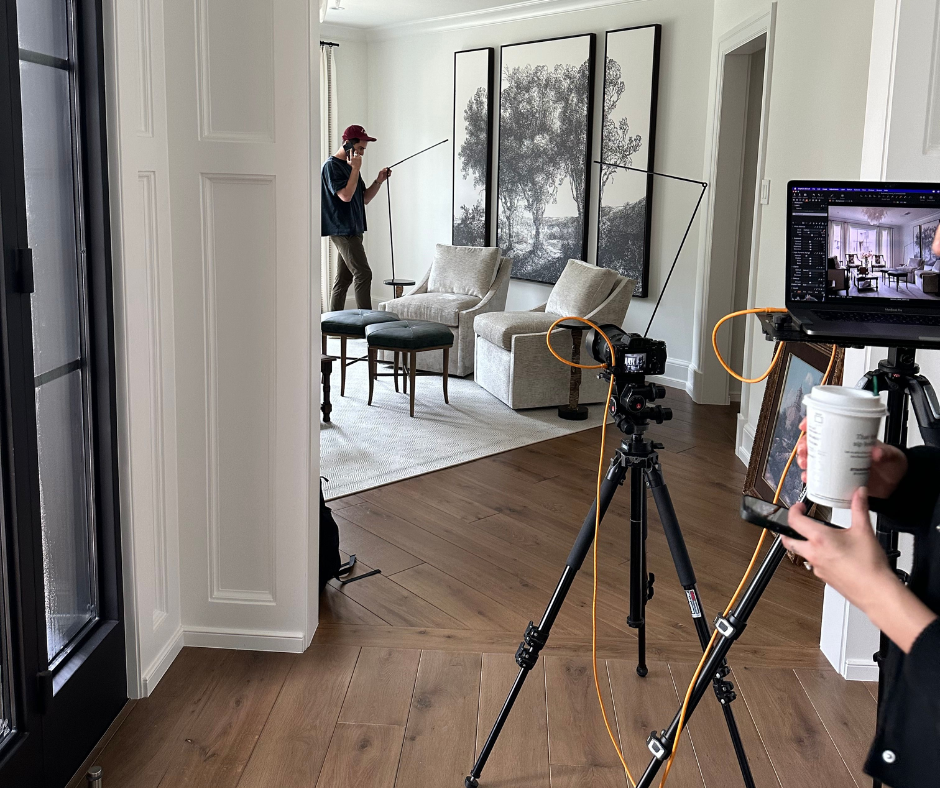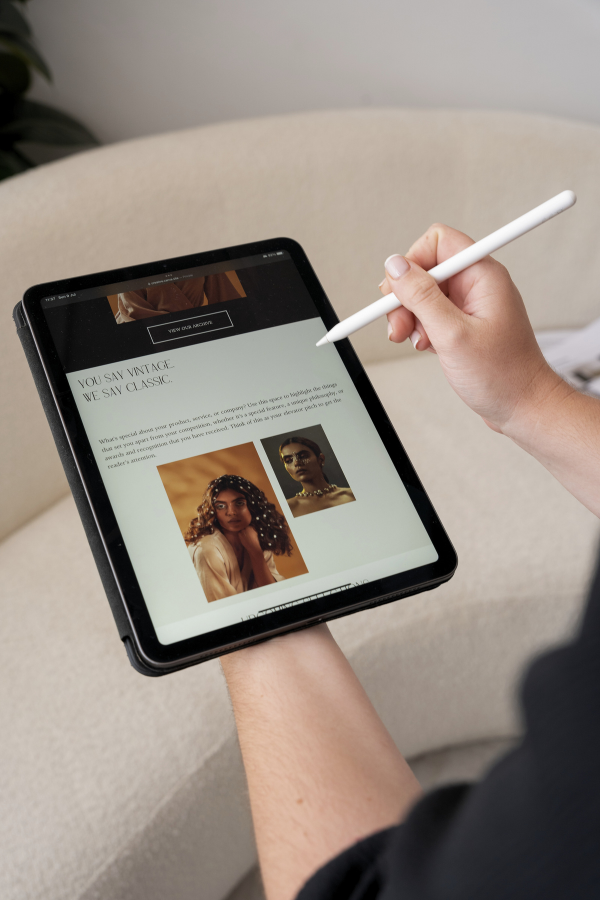
Going from ‘Me’ to ‘We’: How to Finally Trust Your Team as a Firm Owner
Summary
DesignDash co-hosts Laura Umansky and Melissa Grove explore the identity shift from doer to leader. If you’re scaling your design firm but struggling to delegate, this episode explores what it really means to lead with trust, clarity, and empathy—while still honoring your creative spark. From “zooming out” to taking clarity breaks, this is your real-talk guide to letting go without losing your edge.
Reflection Questions
Where in your day-to-day are you still holding on to tasks that could be delegated? Why?
What does your team need from you to feel more trusted, empowered, or supported?
When was the last time you took a clarity break—and what did it reveal about your leadership role?
Journal Prompt
Imagine it’s one year from now.
Your design firm is running smoothly, your team feels trusted, and you finally have space to think, create, and lead. What changed? What did you let go of? How does your day look different—and how does it feel? Write a snapshot of that future and what would need to shift today to move you closer to it.
If you’ve built your design firm from the ground up, chances are you’re used to doing it all: every floor plan, every invoice, every client meeting. But as your business grows, what got you here won’t get you there. In this episode of The DesignDash Podcast, co-hosts Laura Umansky and Melissa Grove unpack one of the trickiest (yet most essential) transitions in a creative career: going from individual contributor to true leader. This is partially about finally feeling comfortable delegating to your team, but it’s also about trust, identity, and learning how to let go without losing your edge.
What Leadership Means—According to the Experts

Leadership is culture; it isn’t just delegating. As a firm owner, you must focus on creating a space where your team feels empowered, supported, and trusted. Harvard Business Review notes that “psychological safety” is foundational to this. Establishing a sense of psychological safety means creating an environment where people feel safe to speak up, take risks, manage conflict, and lead with empathy and inclusivity. In design firms, that translates to fostering spaces where team members can propose bold ideas, admit mistakes, or push back when something feels off without fear of judgment.
Leadership analysts emphasize trust as the non-negotiable core of this foundation. Another HBR article points out that “[i]f leaders aren’t focused on trust, communication, collaboration, and innovation will suffer” . In practice, this means your role includes setting the emotional tone, modeling vulnerability, and making sure everyone feels both seen and empowered.
The 5 Practices of Exemplary Leaders

Grounded in decades of research by James Kouzes and Barry Posner, The Leadership Challenge outlines five actionable leadership behaviors that align closely with creative firm dynamics. These include “modeling the way, inspiring a shared vision, challenging the process, enabling others to act, and encouraging the heart.”
Live your values authentically. If you value creative risk-taking, demonstrate it. Paint a compelling future so your team feels energized by the firm’s mission. Invite experimentation and iterative approaches, even in client projects. Give autonomy and support; trust your team to take the lead (and own the outcomes). Celebrate both design wins and personal growth, regularly and sincerely.
Ask for your employees’ ideas in concept meetings, trust them to lead client touchpoints, and publicly acknowledge their contributions during project presentations.
How to Trust Your Team, with Insights from The DesignDash Podcast
The Identity Shift: From Control Freak to CEO
“Me to we—it’s not just a title change; it’s a mindset shift.” —Laura Umansky
If you’ve built your design business from scratch, chances are you’re deeply familiar with what it means to be an individual contributor: you’ve drafted floor plans at midnight, negotiated with vendors, answered every client email, and probably even mailed out samples yourself. But as co-hosts Laura Umansky and Melissa Grove discuss in this The DesignDash Podcast episode, that same do-it-all energy won’t necessarily serve you as your firm grows. In fact, it might be holding you, and your team, back.
This is where so many firm owners struggle: moving from the comfort of control into the unpredictability of leadership. Letting go of tasks is one thing. Letting go of the identity that came with being the sole expert, the fixer, the go-to? That’s another story entirely.
“Designers are control freaks by nature,” Melissa jokes. “You know you can do it better. But the second you hire someone—even just an assistant—you’re no longer just doing the work. You’re leading.”
And leadership isn’t just about doling out to-do lists. As Laura explains, it’s about reallocating your energy. “It’s not micromanagement—it’s asset allocation,” she says. It’s zooming out, asking not What do I need to get done today? but What does this firm need from me in order to thrive long-term?
Fuel your creative fire, thrive with support from peers, & make 2025 your firm’s best year yet!
JOIN THE DESIGNDASH COMMUNITY

The mistake many founders make is trying to grow while still acting like a soloist. That typically puts your firm in a period of stagnation, a plateau. Instead, leaders must learn to set a vision, make strategic decisions, and—crucially—trust others to execute. Melissa puts it this way: “When you’re leading, you’re not just accountable for the what, but the how and why. That’s a whole different kind of pressure.”
That pressure might be incredibly stressful, but it also produces new freedoms. As Laura shares candidly, “I burned out after COVID. I didn’t want to boss anymore. I was rung out.” But the safety net she’d built through her leadership team allowed her to step back temporarily.
Asset Allocation Over Micromanagement

“It sucks to think of people as assets… but you’re managing the company, not just a project.” —Melissa Grove
Making the leap from doing to leading means changing how you think about your time, your energy, and your team. As Melissa and Laura point out, one of the hardest mindset shifts is moving from day-to-day execution to long-term strategy. In other words: it’s no longer your job to do everything. It’s your job to ensure everything gets done.
That’s where the concept of asset allocation comes in. And yes, calling your team “assets” might feel a little cold, but in context, it’s simply about shifting your focus from input to impact. You are asking, “Where is my time best spent? Where does my team shine? And how do we align those strengths for the success of the whole firm?”
When you’re stuck in individual contributor mode—chasing down orders, fixing tiny mistakes, approving every decision—you’re operating at a micro level instead of a macro level. Leadership means taking a step back and asking the bigger questions: Is this system efficient? Does my team have what they need to succeed? Where are the gaps?
Laura calls this “zooming out.” Zooming out can mean the difference between obsessing over one faucet finish and designing the pipeline that ensures every project flows smoothly without you having to be in the weeds. Ironically, one of the biggest benefits of becoming a true leader is getting time back. It may not look like the creative flow you once had, but it opens up space for what Laura calls “clarity breaks,” which she defines as days to reflect, reset, and reimagine what’s next for your business.
What to Let Go—and What to Keep

“You still need flow state time—even as a leader.” —Laura Umansky
“Being in the work is what feeds me creatively.” —Melissa Grove
Accepting your leadership role doesn’t mean abandoning the work that fuels you; it just means being more intentional about when and how you do it. As Laura and Melissa explain, the biggest trap new leaders fall into is trying to hold onto every task while also setting strategy and managing people. It’s not sustainable.
Instead, leaders must distinguish between what they have to let go of—and what they get to keep.
Fuel your creative fire & be a part of a supportive community that values how you love to live.
subscribe to our newsletter
*please check your Spam folder for the latest DesignDash Magazine issue immediately after subscription

For Melissa, staying engaged in the creative process is absolutely essential: “Being in the work is what feeds me creatively.” But that doesn’t mean she’s in the weeds on every tile sample. It means carving out specific time to do focused, meaningful work—without interruption.
As we noted above, Laura calls this “zooming out,” but also notes how important it is to occasionally zoom in: “If I go too long without flow state time, I’m really freaking unhappy.” Letting go of daily execution is key to running a healthy team, but saving space for your own creative expression is key to staying human—and staying in love with your business.
Not Everyone Needs to Be a Boss

“You cannot put that toothpaste back in the tube.” —Melissa Grove
You’re not “promoting” yourself to leadership as a firm owner; you’re taking on a different job entirely. Sometimes, the very best designers, project managers, or specialists don’t want that job.
Laura and Melissa explore a concept that will be familiar to anyone who’s ever watched a star employee struggle after a promotion: the Peter Principle. This happens when people are promoted to their “level of incompetence,” often because leadership is seen as the only path forward.
The problem is that “You lose the great skill set they had when they were an individual contributor,” Melissa explains. And worse, “everything just kind of starts falling apart.”
Once someone’s been promoted to a role they’re not suited for—especially one they didn’t ask for—there’s rarely a clean path back. “I don’t think there’s ever a situation where they go back,” says Laura. “They either leave, or we part ways.”
The takeaway here is twofold. Not everyone should be a manager. And for firm owners, growth doesn’t always mean promoting your best doers; it means aligning strengths with roles. Some people are meant to specialize (not manage) and that doesn’t make their contributions any less valuable.
Vision Planning When You’re Burned Out

“I couldn’t see the future of the firm because I didn’t even know what would make me happy.” —Laura Umansky
As noted earlier in this article, after COVID, Laura hit a wall. For months, she says, she went into a kind of autopilot. “My mind made me take a step back,” she says.
Thankfully, she was able to see that stepping back wasn’t a failure but a reset. With the support of her leadership team, Laura began re-engaging with her role through clarity breaks and, eventually, vision planning. “Our business coach told me: this quarter, you’re reading The Vision [book] and mapping where the firm is going.” At first, Laura admits, it felt forced. “More projects? Bigger clients? That’s not a vision. That’s operations.”
Only when she gave her mind room to wonder did she actually make progress. Melissa calls this entering your “zone of genius.” “I love just getting to sit down and imagine—where can we really take this?” she says.
Even in a leadership role, burnout is real. And with most forms of burnout, pushing harder isn’t the solution. Sometimes, it’s zooming out, listening to yourself, and redefining what success means to you (and for your firm).
Getting Your Team on Board

“Individual contributors immediately think, how does this impact me?” — Melissa Grove
Leadership isn’t just about having a vision but also communicating it well. When you roll out a new direction, process, or plan, your team’s first reaction might surprise you (in a bad way). As Melissa puts it, “Individual contributors immediately think, how does this impact me?”
That’s not selfishness; it’s human nature. The day-to-day of an individual contributor is necessarily focused, even narrow. So when a leader announces change, whether it’s new goals or new expectations, that can feel destabilizing.
This is why emotional intelligence and empathy are so important in a leadership role. Yes, it’s important to stay objective and avoid decision-making based on emotion alone. But it’s equally important to understand that every shift, from a new org chart to a growth strategy, has a human ripple effect.
This is why Laura and her leadership team focus on transparency and clarity. They don’t just drop a new idea and expect immediate and total compliance. They talk through the why, the when, and the how. “You want to eliminate personal feelings about it,” Melissa says, “but still stay sensitive to how it affects people personally.”
Leaders are messengers. How you deliver each message often determines how well your team receives it.
Final Thoughts: Remember, Leading Isn’t Linear (and That’s Okay)

We have all subscribed to the myth (in business and in life) that progress should be linear: more clients, more team members, more revenue, more responsibility as more years are added to your timeline. But the truth is, success is cyclical. There are periods of burnout, reset, and reinvention.
Laura’s story illustrates this beautifully. After COVID, she didn’t want to boss anymore. She was done. But instead of powering through, she gave herself permission to pause. That clarity gave her not just energy, but direction. Melissa describes this ebb and flow with refreshing honesty: “Sometimes I want to be the visionary. Sometimes I want to make ceramics and ignore the world.”
If you take anything away from this article, we hope it’s that you don’t have to be “on” all the time to be a good leader. You just have to stay attuned to your people, your purpose, and yourself.
There may be seasons when you scale back, regroup, or even consider leaving altogether. That’s not failure. It’s wisdom. Leadership isn’t about grinding endlessly forward. Sometimes, that means slowing down. Other times, it means stepping back so your team can carry the firm.
Written by the DesignDash Editorial Team
Our contributors include experienced designers, firm owners, design writers, and other industry professionals. If you’re interested in submitting your work or collaborating, please reach out to our Editor-in-Chief at editor@designdash.com.








